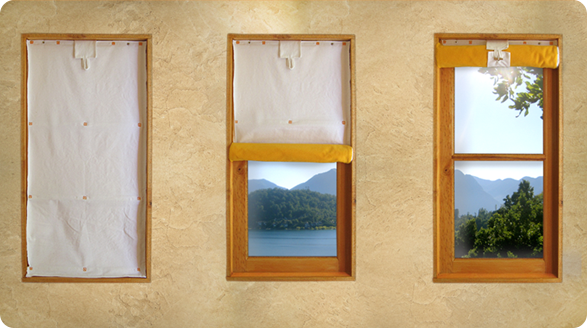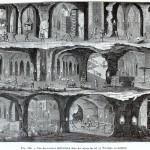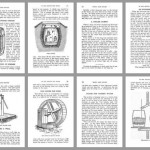The agricultural tool shown in this video is pure genius. However, as some readers on our Facebook-page have noted, turning the soil disrupts soil organisms and brings more weeds. Another human-powered tool, the broadfork, loosens the soil without turning it. Thanks to Jean Armstrong Nick and Austin Liu.
The Case For Dangerous Roads and Low-tech Cars
“The design of automobiles has tended toward insulation, offering an ever less involving driving experience. The animating ideal seems to be that the driver should be a disembodied observer, moving through a world of objects that present themselves as though on a screen. We have throttle by wire, brake by wire, and electrical assist (versus hydraulic assist) brakes, as well as traction control and anti-lock brakes that modulate our driving inputs for us. What all this idiot-proofing and abstraction amounts to is a genuine poverty of information reaching the driver.”
“What’s more, the information that does get through is presented in a highly mediated way, conveyed by potentiometers and silky smooth servos rather than by the seat of your pants. It is therefore highly discreet, and does not reflect fuzzy, subtle variations. Nor is it sensitive to changes that haven’t been anticipated and coded for ahead of time, for example the vibration that might arise from a brake caliper bracket that has come loose or cracked. Perhaps most troubling, the electronic mode of presentation means that information about the state of the car and of the road is competing with information from other electronic devices that may be a lot more interesting.”
Read more: The Case for Dangerous Roads and Low-Tech Cars, Matthew B. Crawford. Picture credit.
Cargo Cults
 “The John Frum movement on the Oceanic island nation Vanuatu is a classic example of what anthropologists have called a “cargo cult”— many of which sprang up in villages in the South Pacific during World War II, when hundreds of thousands of American troops poured into the islands from the skies and seas.
“The John Frum movement on the Oceanic island nation Vanuatu is a classic example of what anthropologists have called a “cargo cult”— many of which sprang up in villages in the South Pacific during World War II, when hundreds of thousands of American troops poured into the islands from the skies and seas.
Cargo cults appear when the outside world, with all its material wealth, suddenly descends on remote, indigenous tribes. The locals don’t know where the foreigners’ endless supplies come from and so suspect they were summoned by magic, sent from the spirit world.
To entice the Americans back after the war, islanders throughout the region started building giant airplanes from wood, carving headphones and radios from bamboo and awaited the messianic serviceman John Frum. They prayed for ships and planes to once again come out of nowhere, bearing all kinds of treasures: jeeps and washing machines, radios and motorcycles, canned meat and candy. Their rituals included the non militant army TAU (Tanna Army USA), marching with wooden rifles.
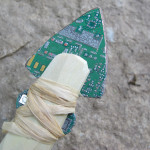 The more naive will laugh about these imitations. But did the US soldiers truly understand their technology, their big agenda? The cult of the cargo is our world exactly: We perform meaningless routines we call work, in hope for future cargo. With a technology that could navigate us to the moon, we write LMAO. The western world itself is a giant cult of imitating things that somehow work: dressing in suits, using buzzword-vocabulary, mimicing old forms of art. The longing for godlike goodies on the horizon, the usage of things we don´t understand: it’s a big parable of desire.
The more naive will laugh about these imitations. But did the US soldiers truly understand their technology, their big agenda? The cult of the cargo is our world exactly: We perform meaningless routines we call work, in hope for future cargo. With a technology that could navigate us to the moon, we write LMAO. The western world itself is a giant cult of imitating things that somehow work: dressing in suits, using buzzword-vocabulary, mimicing old forms of art. The longing for godlike goodies on the horizon, the usage of things we don´t understand: it’s a big parable of desire.
Surprisingly the local performers of the Cargo Cults succeeded: By remaking western technology with bamboo, by re-enacting western rituals they attracted actual planes full of tourists and anthropologists.”
Quoted from “In John they trust” (Smithsonian Magazine) and “The supercargo manifesto” (Supercargo Tumblr). Pictures: Supercargo Tumblr. Thanks to Edwin Gardner.
A Washing Machine for Life
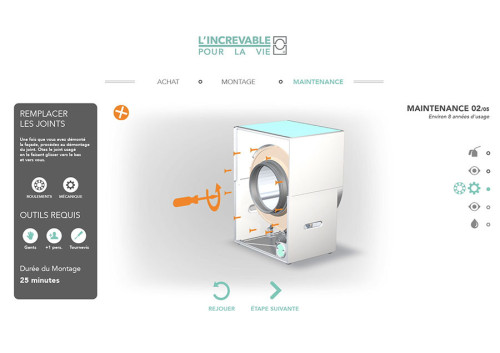 “L’Increvable (which means indestructable in French) is the concept of a washing machine whose lifespan is fifty years. Gone are the days when your washing machine had an abrupt end of life after 5 years of use because of a single bearing.
“L’Increvable (which means indestructable in French) is the concept of a washing machine whose lifespan is fifty years. Gone are the days when your washing machine had an abrupt end of life after 5 years of use because of a single bearing.
With L’Increvable you change each component when needed. You don’t have to be a handy(wo)man: the Increvable website guides you through each component maintenance thanks to well-documented tutorials and each new component is delivered with proper tools.
You buy the washing machine in flat-pack form and then you assemble it yourself : it gives you the opportunity to get to know the machine. The traditional 30 kg (60 lbs) of cement ballast are replaced by a water tank. The latter is automatically filled during the first use of the machine. This means that the machine can be made lighter again when it needs to be moved.
By removing all highly technical and hardly replaceable parts from the structure and built with such specifications from the ground up, the Increvable is destined to be easily manipulable by the mere user. The missing technologic parts (i.e. touchable screen) do change the User Experience in a very fundamental way, giving maybe to some of us a certain old school feel to the tech but adds several dozens of years before obsolescence as a result.”
See & read more: 1 / 2 / 3. Thanks to Christopher Santerre.
The Kume Shade: DIY Insulating Curtain
The Kume curtain is a simple and inexpensive home-made insulating curtain that can help save money, keep our homes cozier and be kinder to the environment.
The Kume is a roll-up curtain that is composed of four distinct layers.
- A front panel which acts as the first layer and seals the perimeter of the window opening when the curtain is closed
- A moisture barrier which prevents indoor humidity from reaching the window and condensing on the cold glass and window frame
- Wooden battens which maintain the fabric stretched out and thereby ensure that the curtain fits tightly against both sides of the window opening (the battens also create air pockets which further reduce heat losses through the curtain)
- A back panel which acts as the final layer of insulation and helps seal the perimeter of the window opening when the curtain is closed.
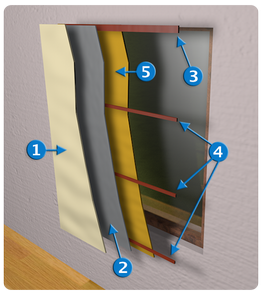 Why is a Kume curtain so effective at reducing heat loss?
Why is a Kume curtain so effective at reducing heat loss?
- Still air is one of the best insulators found in nature, and the Kume curtain contains a lot of it. First, between the fibers of the thick polar fleece that is used to make the curtain, and second inside the thin spaces that are created between the front and back panels by the battens.
- When closed, the Kume curtain fits tightly against the top, bottom and sides of the window opening. By doing so it traps a layer of insulating air between the glass and the curtain, and prevents the cold air that forms against the glass from seeping into the room.
- A Kume curtain basically works just like a good down jacket on a cold winter day. The air that is trapped in the thick layer of down creates an effective insulating layer, and the tight fit of the jacket around your waist, neck and wrists keeps your body heat in, rather than letting it leak out into the cold environment.
See and read more (including construction plans) at Kume Insulating Curtains. Via BuilditSolar. Thanks to Frank Van Gieson.


